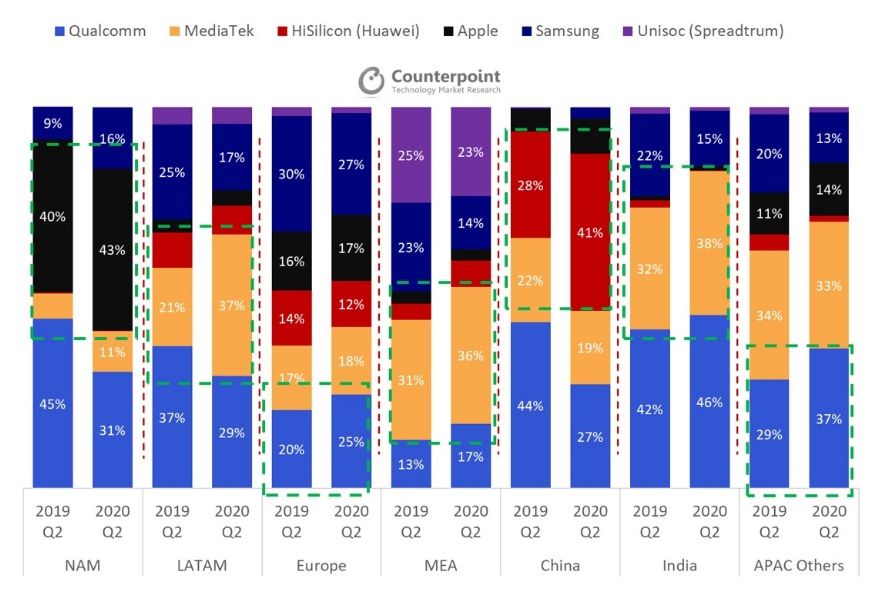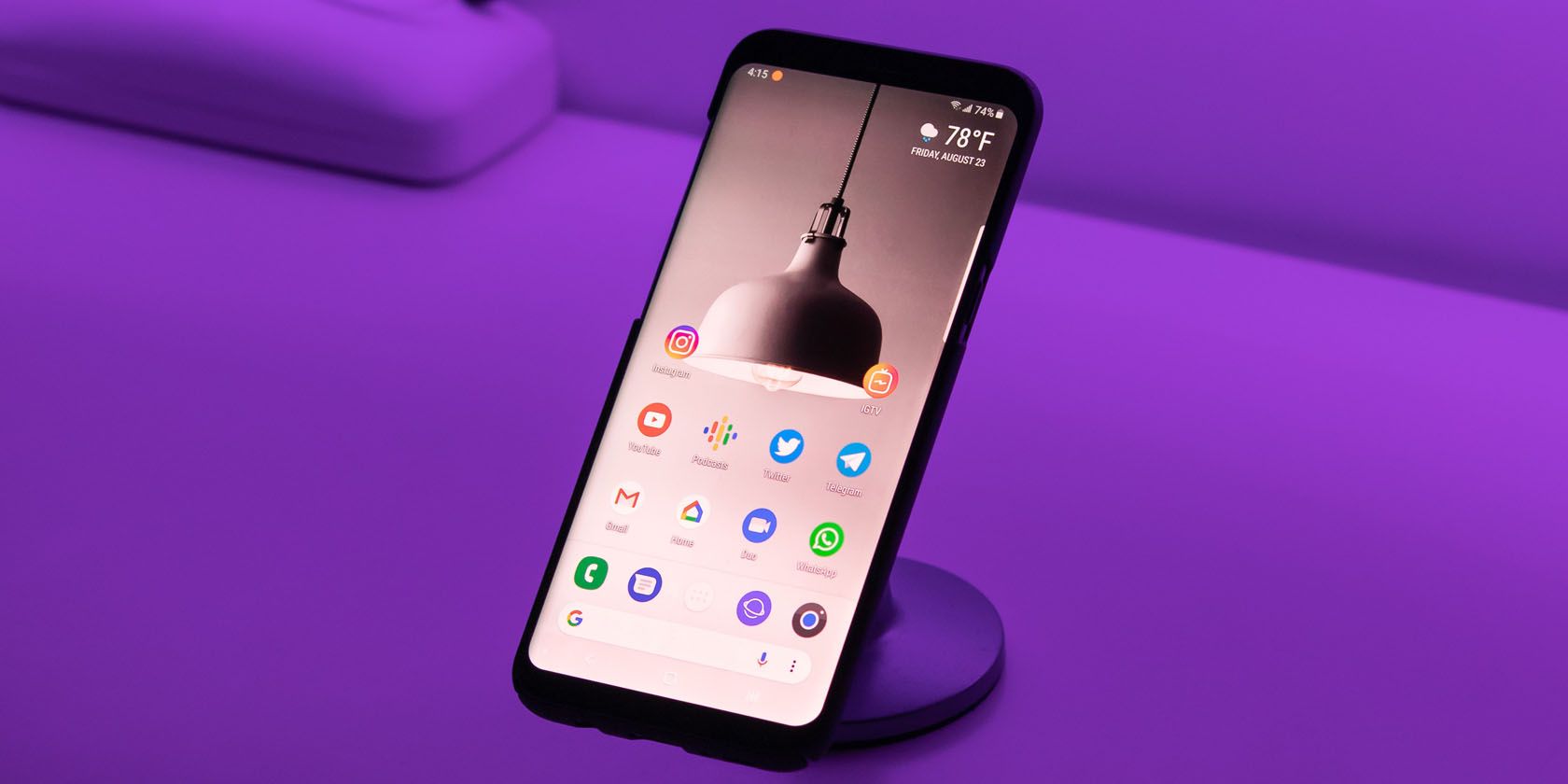Just as Intel and AMD are the two primary choices of PC processors, so are MediaTek and Snapdragon the main CPU choices for smartphones.
Due to the complexity of the ever-shrinking computer chips, only a few smartphone brands produce their own hardware. Instead, most integrate chipsets from a couple of semiconductor manufacturers.
By the end of this article, you will understand the differences between MediaTek and Qualcomm’s Snapdragon. More importantly, when you are looking to buy your next phone, you will know the terminology involved to make the best purchasing decision.
Breakdown of the Mobile Chipset Market Share
Although there are regional differences, on a global scale, Qualcomm and MediaTek keep expanding their chipset footprint. According to Counterpoint Technology Market Research, here is what the breakdown looks like.

As you can see, much more expensive Apple smartphones dominate the North American market, with some success in Europe. On the other hand, affordable Android smartphones dominate the rest of the world, represented by two colors—blue Qualcomm and yellow MediaTek. In addition, China has its own chip-making ecosystem led by HiSilicon, which is owned by Huawei.
Qualcomm and MediaTek have been so successful because they provide the same app-powering functionality within much wider price ranges. Furthermore, more people are seeking smartphones with gaming capabilities. This requires higher refresh rates—60 Hz, 120Hz, 144 Hz—and higher clocked GPU chips.
However, it is important to understand how their chips are built before we go into the differences between Qualcomm’s Snapdragon and MediaTek.
System on a Chip (SoC) as the Mobile Platform
Because everything has to effectively fit within the size of a credit card, microprocessors are integrated on a System on a Chip (SoC) circuit board. The first such integrated circuit was developed all the way in 1958 by Jack Kilby. However, modern SoC is far more advanced, combining the following core elements:
- Memory: RAM, ROM, or EEPROM
- CPU: Central Processing Unit responsible for the performance of generalist tasks
- GPU: Graphics Processing Unit responsible for the performance of visual tasks (games, video editing, etc.)
- Connectivity: USB, HDMI, Wi-Fi, Bluetooth, Ethernet
On a PC, you can swap out the GPU, CPU, and RAM, and even your motherboard. However, a mobile SoC uses an integrated design to save space, so even upgrading memory is impossible. SoCs are drastically more energy-efficient and compact—just what a smartphone needs.
Therefore, when we talk of smartphone performance, we cannot separate between CPUs and GPUs, as is common when discussing PCs and other desktop computers. Because all the key components are integrated, we have to rely on the manufacturer to provide us with the best combo that fits our needs at the price we can afford.
Qualcomm Snapdragon Overview

Not many know that Qualcomm acquired AMD’s Handheld Graphics and Multimedia Assets in 2009. As a result, what we know today as Adreno is an anagram of Radeon—a homage to AMD’s legacy. While Snapdragon is Qualcomm’s SoC solution, Adreno GPU became its integral part.
Accordingly, when you look up smartphone performance, you will always see two parts—the SoC series and GPU series. For instance, the current top-performing Snapdragon chipsets are:
- Snapdragon 888 (Adreno 660): OnePlus 9 Pro, Xiaomi Mix 4, Samsung Galaxy S21 Ultra ($700–$1100 price range). Support for the latest 5G.
- Snapdragon 870 (Adreno 650): Motorola Edge 20 Pro, Xiaomi Poco F3, Vivo X60 Pro ($350–$800 price range)
- Snapdragon 865 (Adreno 650): Samsung Galaxy S20, OnePlus 8, Sony Xperia Pro ($400–$800 price range)
You will find all of these models within the top 10 performing smartphones. Their prices vary depending on the manufacturer and RAM capacity. The higher the series number, the better the phone will perform, and the more expensive it will be.
Likewise, the smartphones with hardware from the series under the Snapdragon 865, the Snapdragon 860/Adreno 640, should cost less than $300. The Snapdragon 600 and 700 series are for budget-oriented customers, while the Snapdragon series 800 represents flagship phones with all the bells and whistles one could want—from multiple cores and cameras to top-notch gaming performance.
MediaTek Overview
This Taiwanese company started its technological journey with DVD players and TVs, spreading out to wireless SoC solutions. After March 2021, MediaTek outpaced Qualcomm as the global chipset vendor for smartphones. In 2020 alone, it shipped over 350 million chipsets to various smartphone companies.
MediaTek’s line of SoCs is called Helio, renowned for having multiple cores for increased background performance. You will often see them as Hexa (6), Octa (8), or even Deca (10) cores for flagship phones. Mediatek’s GPU solution is a third-party one called Mali. Accordingly, top phones with MediaTek chipsets will have the following series:
- Helio G95 (Mali-G76 MC4): Motorola Moto G60S, Xiaomi Redmi Note 10S
- Helio G90T (Mali-G76 MC4): Realme 6, Xiaomi Redmi Note 8 Pro
- Helio G85 (Mali-G52 MC2): Realme Narzo 30A, Xiaomi Redmi Note 9
Unlike the Snapdragon series, even the highest MediaTek chipsets are budget-oriented, all of them obtainable for under $300.
Snapdragon vs. MediaTek: Power Versus Price

While Snapdragon chipsets regularly fill the top 10 smartphones performance rankings, the best MediaTek SoCs rarely enter above the top 20. That is, if Huawei’s Kirin, Samsung’s Exynos, and Apple’s A-series are added to the mix. Bear in mind that Kirin and Exynos SoCs also have configurations with third-party Mali GPUs.
With these combos, they quickly rise as top-performing phones. Specifically, those with Exynos 2100 (Mali G78 MP14) or Kirin 9000 (Mali-G78 MP24) configuration. On the other hand, Snapdragon 888 (Adreno 660) outperforms both, left behind only by Apple’s latest A14 Bionic and A13 Bionic.
The top MediaTek offering—Helio G95 (Mali-G76 MC4)—lags behind even the Snapdragon 835 (Adreno 540), released four years ago. However, affordability is the key to MediaTek’s rising international success. It may not have the horsepower to compete with Snapdragon, but it wins in the bang for the buck ratio.